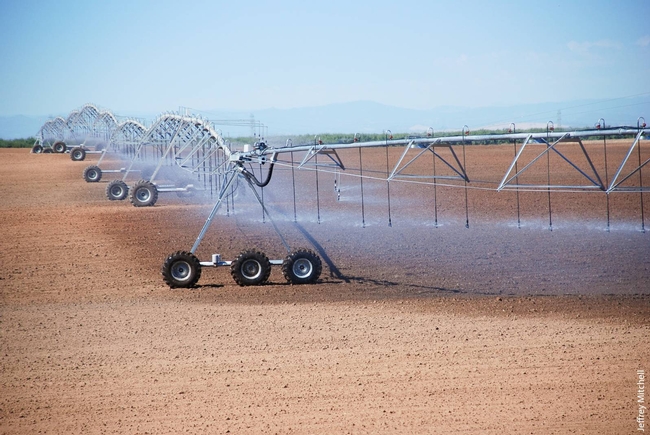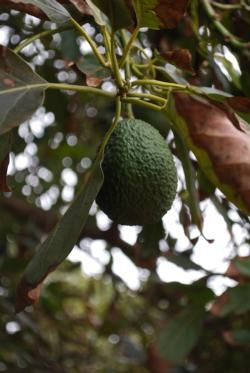
Posts Tagged: Tom Turini
Researchers see more overhead irrigation in California’s future

That is beginning to change.
UC Cooperative Extension and Fresno State agricultural production scientists researched overhead irrigation at the UC West Side Research and Extension Center for five years, growing wheat, corn, cotton, tomato, onion and broccoli and comparing them with crops produced under furrow and drip irrigation. With all of them except tomato, overhead irrigation led to similar or increased yields, according to the scientists' report published in the current issue of California Agriculture journal.
“Overall, we are very encouraged by these results, and they reflect the experiences that many California farmers have recently been having with overhead irrigation systems,” said lead author Jeff Mitchell, UC Cooperative Extension specialist. “We've confirmed that overhead irrigation systems work in California. We also concluded that there are opportunities to get even better results with more research and experience, particularly when overhead irrigation is coupled with practices that preserve crop residues and rely on reduced tillage.”
The article co-authors are Anil Shrestha, weed scientist at Fresno State; Joy Hollingsworth, UCCE staff research associate; and Dan Munk, Kurt Hembree and Tom Turini, UCCE advisors in Fresno County.
The tomato yields under overhead irrigation were disappointing, particularly since tomatoes have a prominent role in many Central Valley annual crop rotations.
“This isn't a simple process,” Mitchell said. “You can't just turn it on and let it go. It will require focused and dedicated farmer and researcher attention and innovation to solve.”
The authors are working with a team of Central Valley tomato farmers, processors, irrigation experts and research colleagues to improve overhead irrigation management in tomatoes. They are encouraged by the success of Walnut Grove farmer Michael Boparai, who achieved profitable processing tomato yields with overhead irrigation.
Overhead irrigation systems were invented more than 60 years ago. They now irrigate 50 percent of total U.S. farm irrigated acreage. In Nebraska, 87 percent of irrigated land is under overhead systems. By contrast, in California overhead systems irrigate only 150,000 acres, just 2 percent of the state's irrigated farmland.
Mitchell and his co-authors outlined several factors that contributed to its slow rate of adoption in California:
- Early adopters ran into serious problems, giving the systems an undeserved bad reputation that persists even though in recent years California farmers are using the systems successfully.
- Center pivot systems typically leave the corners of the field unirrigated, which can reduce production.
- Purchase and installation cost of the overhead system is substantially higher than furrow irrigation.
However, the UC and Fresno State research has shown many advantages.
- Overhead irrigation can be managed remotely and automatically.
- The system can accommodate different terrain and soil types.
- Overhead systems requires less maintenance than drip systems in terms of avoiding clogging of emitters and repairing leaks.
- Overhead irrigation may also help with salinity management by uniformly leaching salts from a crop's root zone.
- Precision irrigation, including overhead systems, are becoming ever more critical with coming groundwater regulations, surface water cuts and the increasing cost of water for farmers in California.
A significant advantage of overhead irrigation is its compatibility with other farm management technologies that optimize the farming system and reduce costly inputs, including water, fuel, labor and fertilizer.
“We're committed to continuing our work on the whole package – reduced tillage, preserving residue, improving water infiltration, improving soil water-holding capacity and increasing productivity uniformity – a system that we refer to as conservation agriculture,” Mitchell said. “We are working to encourage adoption of conservation agriculture in crops where viability of the system is well established, and facilitate the research and innovation needed to optimize conservation agriculture production in additional crops.”
Drought is forcing changes in California ag

It takes 74 gallons of water to produce one pound of avocados — and drought-stricken California produces 95 percent of the avocados grown in the United States, wrote reporter Padma Nagappan.
Bender has been working with several farmers to experiment with high-density avocado planting, in which the trees are pruned to grow up rather than out. Growing more trees on less land will reduce water costs.
“The only way you can compete with cheaper imports and the high cost of water is if you go high-density and get more production per acre," said a San Diego area farmer.

An article in Growing Produce said the state has issued curtailments to some farmers who hold surface water rights. Because water rights law is so complex and because this is the first time many growers have had to navigate the finer details of water rights, Brenna Aegerter, University of California Cooperative Extension advisor in San Joaquin County, suggests that growers consult a professional for targeted advice.
Because of reduction in surface water availability, many growers are turning to groundwater to irrigate their crops. However, groundwater presents its own set of challenges, Aegerter says.
“There's a shallow water table but it's not good quality,” Aegerter says. “It's salty water. I think right now the main concern is what the water quality is going to be — whether it's going to be salty, and whether that will affect the crops.”
In the Westlands Water District, growers are using a combination of increased reliance on groundwater and fallowing for their water management plans, according to Tom Turini, UCCE advisor in Fresno County.
“The groundwater is lower quality than the district water — with levels of total dissolved salts and toxic ions varying from well to well — but generally higher than ideal, ” Turini says.
Processing tomatoes facing a critical threat: curly top

Daniel interviewed Tom Turini, UC Cooperative Extension advisor in Fresno County. He said it's common to find some tomatoes infected with curly top, but this year is much worse than usual. The virus is transmitted by beet leafhoppers, which in dry years arrive early from coastal foothills and infect a bigger swath of cropland.
Fresno county has about 100,000 acres of processing tomatoes. Some fields have been completely lost.
"It is likely we're going have lower production in this area, which does account for over a third of California processing tomato production," Turini said.
Listen to the report here:
For more on curly top virus, see the UC Pest Management Guidelines for the disease.
